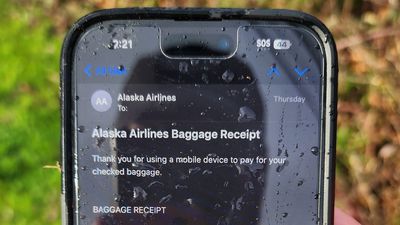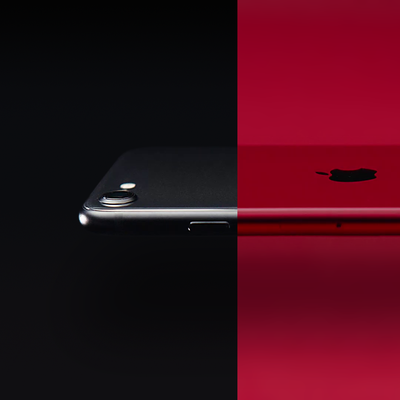iPhone Survives 16,000-Foot Drop After Alaska Airlines Plane Incident
An iPhone that was expelled from the cabin of Alaska Airlines flight 1282 on Friday survived a fall of more than 16,000 feet and was discovered intact.

Vancouver, Washington resident Sean Bates shared images of the device on Sunday after he found it on the side of Barnes Road in Portland, Oregon. The iPhone was in full working condition and was in fact still open to an Alaska Airlines email. There were no cracks on the display, though it was protected by a case and presumably landed in a forested area with soft ground cover.
Bates alerted the National Transportation Safety Board, and officials came out to collect the device. The NTSB told Bates that it was the second phone to be found from the flight in the area.
The iPhone was
expelled from Alaska Airlines flight 1282 after a portion of the plane blew out shortly after it took off from the Portland International Airport. The aircraft was able to safely land back at the Portland airport, and all passengers and crew members survived.
The sudden depressurization in the cabin of the plane caused items like smartphones to be sucked out, where they fell to the ground below. In 2011, Wired wrote a piece on the terminal velocity of an iPhone falling from a plane, which is a good explainer on how the device was able to survive. In a nutshell, the low weight and maximum speed of the iPhone leads to a limited amount of force on landing despite the height of the fall, so the end result isn't too much different from dropping it from a lower height.
There were two smartphones found from the plane, along with other debris such as the plug door that may give some insight into what went wrong.
Popular Stories
In select U.S. states, residents can add their driver's license or state ID to the Apple Wallet app on the iPhone and Apple Watch, and then use it to display proof of identity or age at select airports and businesses, and in select apps.
The feature is currently available in 13 U.S. states and Puerto Rico, and it is expected to launch in at least seven more in the future.
To set up the...
While the iPhone 18 Pro and iPhone 18 Pro Max are not expected to launch for another nine months, there are already plenty of rumors about the devices.
Below, we have recapped 12 features rumored for the iPhone 18 Pro models.
The same overall design is expected, with 6.3-inch and 6.9-inch display sizes, and a "plateau" housing three rear cameras
Under-screen Face ID
Front camera in...
Earlier this month, Apple released iOS 26.2, following more than a month of beta testing. It is a big update, with many new features and changes for iPhones.
iOS 26.2 adds a Liquid Glass slider for the Lock Screen's clock, offline lyrics in Apple Music, and more. Below, we have highlighted a total of eight new features.
Liquid Glass Slider on Lock Screen
A new slider in the Lock...
2026 is almost upon us, and a new year is a good time to try out some new apps. We've rounded up 10 excellent Mac apps that are worth checking out.
Subscribe to the MacRumors YouTube channel for more videos.
Alt-Tab (Free) - Alt-Tab brings a Windows-style alt + tab thumbnail preview option to the Mac. You can see a full window preview of open apps and app windows.
One Thing (Free) -...
Apple hasn't updated the Apple TV 4K since 2022, and 2025 was supposed to be the year that we got a refresh. There were rumors suggesting Apple would release the new Apple TV before the end of 2025, but it looks like that's not going to happen now.
Subscribe to the MacRumors YouTube channel for more videos.
Bloomberg's Mark Gurman said several times across 2024 and 2025 that Apple would...
Samsung is working on a new foldable smartphone that's wider and shorter than the models that it's released before, according to Korean news site ETNews. The "Wide Fold" will compete with Apple's iPhone Fold that's set to launch in September 2026.
Samsung's existing Galaxy Z Fold7 display is 6.5 inches when closed, and 8 inches when open, with a 21:9 aspect ratio when folded and a 20:18...
The European Commission today praised the interoperability changes that Apple is introducing in iOS 26.3, once again crediting the Digital Markets Act (DMA) with bringing "new opportunities" to European users and developers.
The Digital Markets Act requires Apple to provide third-party accessories with the same capabilities and access to device features that Apple's own products get. In iOS...
Apple is working on a foldable iPhone that's set to come out in September 2026, and rumors suggest that it will have a display that's around 5.4 inches when closed and 7.6 inches when open. Exact measurements vary based on rumors, but one 3D designer has created a mockup based on what we've heard so far.
On MakerWorld, a user named Subsy has uploaded a 1:1 iPhone Fold replica (via Macworld), ...
With the end of 2025 near, the time has come to look back at the devices and accessories that Apple discontinued throughout the year.
Most of the products that were discontinued this year were simply replaced by a new model with an updated chip. However, the iPhone SE line was entirely discontinued when the iPhone 16e launched, and the iPhone Plus line is being phased out.
Below, we have...

























